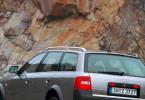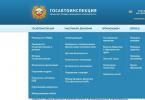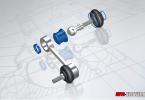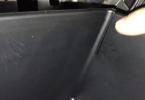Traction control is a collection of mechanisms and electronic components of a car that are designed to prevent slipping of the driving wheels. TCS (Traction Control System) is the trade name for the traction control system that is installed on Honda vehicles. Similar systems are installed on cars of other brands, but they have different trade names: traction control TRC (Toyota), traction control ASR system(Audi, Mercedes, Volkswagen), ETC system ( Range rover) other.
The activated TCS prevents the driving wheels of the car from slipping when starting to move, sharp acceleration, cornering, bad road conditions and fast lane change. Consider the principle of operation of TCS, its components and general arrangement, as well as the pros and cons of its operation.
How TCS works
Principle of operation traction control systemGeneral principle The operation of the Traction Control System is quite simple: sensors included in the system register the position of the wheels, their angular speed and the degree of slippage. As soon as one of the wheels starts to slip, TCS instantly removes the loss of traction.
The traction control system deals with slippage in the following ways:
- Braking of skidding wheels. The braking system is activated when there is no high speed- up to 80 km / h.
- Reducing the torque of the car engine. Above 80 km / h, the engine management system is activated, which changes the amount of torque.
- Combining the first two methods.
Note that Traction Control System is installed on vehicles with antilock braking system (ABS - Antilock Brake System). Both systems use the readings of the same sensors in their work, both systems pursue the goal of providing the wheels with maximum grip on the ground. The main difference is that ABS limits wheel braking, while TCS, on the contrary, slows down a rapidly rotating wheel.
Device and main components
 ABS + TCS system diagram
ABS + TCS system diagram Traction Control System is based on anti-lock braking system elements. The anti-slip system uses electronic blocking differential, as well as the engine torque management system. The main components required to implement the functions of the TCS traction control system:
- Feed pump brake fluid... This component creates pressure in the vehicle's braking system.
- Switching solenoid valve and solenoid valve high pressure... Each drive wheel is equipped with such valves. These components control braking within a predetermined loop. Both valves are part of the ABS hydraulic unit.
- ABS / TCS control unit. Manages the traction control system using the built-in software.
- The engine control unit. Interacts with the ABS / TCS control unit. The traction control system connects it to work if the speed of the car is more than 80 km / h. The engine management system receives data from sensors and sends control signals actuators.
- Wheel speed sensors. Each wheel of the machine is equipped with this sensor. The sensors register the rotational speed, and then transmit signals to the ABS / TCS control unit.
 TCS on / off button
TCS on / off button Note that the driver can disable the traction control system. Usually on dashboard there is a "TCS" button that enables / disables the system. Deactivation of TCS is accompanied by illumination of the indicator "TCS Off" on the dashboard. If there is no such button, then the traction control system can be disabled by pulling out the appropriate fuse. However, this is not recommended.
Advantages and disadvantages
The main advantages of the Traction Control System:
- confident start of the car from a place on any road surface;
- vehicle stability when cornering;
- traffic safety in various weather conditions(ice, wet canvas, snow);
- reduced tire wear.
Note that in some driving modes, the traction control system reduces engine performance, and also does not allow full control of the vehicle's behavior on the road.
Application
Anti-slip TCS system installed on cars Japanese brand Honda. Similar systems are installed on the cars of other automakers, and the difference in trade names is explained by the fact that each carmaker, independently of the others, developed an anti-slip system for its own needs.
The widespread use of this system has made it possible to significantly increase the level of vehicle safety while driving due to continuous monitoring of the grip with road surface and improved handling when accelerating.
In this article, we will try to understand the principle of the car's braking systems - ABS, ESP and TSC.
How do ABS, ESP and TSC work?
The first systems to prevent the wheels from locking and allow the driver to steer too much on the brake pedal to drive a car were introduced more than thirty years ago. These anti-lock braking systems became known as ABS.ABS consists of wheel speed sensors, modulator brake pressure and electronic unit management. The task of the sensors is to record the beginning of wheel blocking. As soon as this has happened, the signal is transmitted to the control unit, which gives the command to the modulator, which lowers the pressure of the fluid in the hydraulic system of the brakes. When the wheel is unlocked and starts to rotate again, the fluid pressure returns to its original value and again forces brakes work.
The processes of braking and releasing the wheels will be cyclically repeated until the threat of blocking disappears. The driver feels ABS work by shocks transmitted to the brake pedal.
Wheels are also capable of slipping at the moment of the start of movement, during acceleration, in cases of vigorous movement on sections with surfaces of different adhesion properties. The desire to get rid of these shortcomings led to the appearance.
When the drive wheels begin to rotate faster than the driven ones, this is perceived by the processor as slipping. Further, two options are possible. First, the electronics will "strangle" the engine, not paying attention to how the driver actively presses on the gas pedal; the second - the drive wheels are braked until they stop slipping and catch the tread on the coating. However, both scenarios usually "work".
 What is remarkable about the TCS is the ability of the system, which is an "add-on" to ABS, to independently control the engine and brakes of individual wheels. The designers were able to approach the development of another electronic assistant- programs electronic stabilization ESP (Electronic Stability Program)... In addition, the opportunity electronic control traction and brakes were used to simulate a differential lock.
What is remarkable about the TCS is the ability of the system, which is an "add-on" to ABS, to independently control the engine and brakes of individual wheels. The designers were able to approach the development of another electronic assistant- programs electronic stabilization ESP (Electronic Stability Program)... In addition, the opportunity electronic control traction and brakes were used to simulate a differential lock.
What are the disadvantages of ABS? This system, by regulating the pressure of the brake fluid, protects the wheels from blocking and provides the driver, even with his panic actions, the ability to drive the car. But getting out of critical situation he must himself, relying on his own skill and composure. What if that's not enough?
Example: a car enters a bend at too high a speed, and depending on the direction of the turn, it is blown either into a ditch or onto oncoming lane... The driver brakes sharply in response and additionally turns the steering wheel in the direction of drift, wanting to stay on a safe trajectory. As a result - drift or skid, although ABS did not allow the wheels to slip.
If the car was equipped with ESP, this would not have happened. ESP will reduce fuel delivery to match engine power and RPM, and with it, vehicle speed, to meet the needs of the situation. But the main thing is that ESP will choose braking forces for each wheel separately, and in such a way that the resulting braking forces counteracted the moment trying to turn the car, and kept it on the trajectory.
 If a skid starts when entering a turn rear axle, ESP will provide braking of the external front wheel... This creates a stabilizing moment that returns the vehicle to a safe driving path. If the car's understeer is too low, which causes the front wheels to drift off the bend, ESP will slow down the rear inner wheel, helping the driver maintain control of the car.
If a skid starts when entering a turn rear axle, ESP will provide braking of the external front wheel... This creates a stabilizing moment that returns the vehicle to a safe driving path. If the car's understeer is too low, which causes the front wheels to drift off the bend, ESP will slow down the rear inner wheel, helping the driver maintain control of the car.
For ESP to work, Yield, Lateral Acceleration and Steering Wheel Position sensors had to be added to the existing wheel sensors and software processor. As a result, ESP not only monitors the speed of rotation of each of the wheels and the pressure in the braking system, as does ABS, but also monitors steering movements, lateral acceleration of the car, its angular speed, and controls the operating modes of the engine and transmission.
He will talk about what the ABS, ESP and TSC systems are like, what is the difference between them and what is the principle of their work.
Imagine modern foreign car without auxiliary system braking or air conditioning is simply impossible, often it is no longer a luxury, but a necessary component of the equipment.
Accidental obstacle or accidental pressing of the brake pedal, skidding of the car can lead to loss of control and death. Every driver has had such a case.
What is ABS, TSC and ESP

The first systems that allowed the driver to align the car and keep the course of movement began to be established twenty years ago. ABS or more, are not now installed on cars, since newer ones came in their place, but still, they were the beginning of systems directional stability.
There are three main components in ABS:
- Sensors for picking up the wheel speed;
- A device for changing the pressure in the brakes, for each wheel separately;
- Process control unit.
Not unimportant systemic is considered to be TSC, better known as ASC or ASR. Allows you to start from a place without slipping the driving wheels, it is very convenient to use when starting on snow or a track covered with ice. The system is based on the same sensors, only the control module has been improved, the wheel recognition function has been added to it. Thus, if during the start, the drive wheels rotate faster than the driven ones, then the control system perceives this as wheel slip. The control unit will reduce the engine speed, no matter how hard you press the gas pedal, and the car moves gently.
A newer and more modernized ESP ("Vehicle Stability System") system can not only manage braking system but also the engine. On SUVs, it was endowed with the ability to lock a differential. In cars BMW brands it's an x-Drive, and on a Mercedes it's a 4-Matic. In addition to the standard sensors that were used in ABS, we also added side sensors, steering, skid and other sensors that make it clear to the system what is happening with the car while driving. Thus, when the system is turned off, all data is transmitted to the monitor. on-board computer, and make it clear to the driver about the situation on the road, the temperature outside the car and what the state of the road is. This greatly facilitates driving and gives confidence in the car, even without the system, you can make a decision in a given situation to maneuver.

Consider a situation when a car enters a turn and starts to skid to the side, turning the steering wheel in the direction of a skid, the driver will go out of the bend, and ABS will slow down as expected. But still, the last decision will remain with the driver, turn down the gas or slow down. In the presence of ESP systems, the situation will be completely different. First, it will reduce the fuel supply in order to reduce the rpm and engine power, because of this, the speed will decrease. Further, the system will automatically determine which of the wheels should slow down more and which should not be touched at all, using the steering sensors, it will tell you which way to turn the steering wheel to return to the previous driving trajectory.
Experienced drivers say that you should not play with these systems, that is, you should often press the brake pedal in a row, then the system will perceive it as emergency situation and will start working unnecessarily.
Video on how the ABS system works:
Traction control system TCS is a complex of software and hardware devices and vehicle mechanisms designed to prevent slipping of the vehicle's driving wheels.
The English abbreviation stands for Traction Control System (TCS). Such a system is used in literal literature on Honda cars.
For other car brands, the abbreviation for traction control has a different look, for example:
- TRC for Toyota;
- ASR for Audi, Mercedes and Volkswagen;
- ETC for Rovers.
Most vehicles have a dedicated button that activates and deactivates the TCS function.
The principle of operation of the TCS traction control system
This anti-skid system works in conjunction with the ABS system. In most vehicles, information processing is also carried out in the ABS control unit, then it is transmitted to generate control signals to the engine control unit.
The traction control system in its work is guided by the indicators of the speed sensors of the driving wheels. If the car is four-wheel drive, then the system uses the readings of all sensors.
Wheel rotation sensors generate pulses, the frequency of which is proportional to angular velocity rotation of the wheels. If the pulse frequency of the rotation sensor of any wheel is significantly higher than the pulse frequency of other wheels, therefore, the wheel has entered an uncontrolled slip mode.
Video - how the TCS traction control system works on the UAZ Patriot:
In order to prevent this phenomenon, the TCS generates a signal that is sent to the engine control unit to reduce thrust or to ABS system to brake the corresponding wheel.
Thus, slipping can be eliminated by:
- braking of the corresponding wheel by the ABS system;
- forced reduction of engine power (usually turned on at high speeds);
- joint work of two channels of wheel torque control.
Adjusting (decreasing) engine torque is usually done by:
- decrease in fuel supply;
- throttle valve adjustment;
- by changing the ignition angle.
Its advantages and disadvantages
TCS is designed for automated alignment of the vehicle's trajectory in uneven slippery road surfaces. It is relevant for drivers with little driving experience.
TCS provides:
- uniform and straight start from the place of the car on a slippery road surface;
- regular cornering;
- reduced tire wear.
Given the peculiarities of the traction control system, it also has disadvantages:
- decrease in productivity power unit due to the forced reduction of the torque;
- the possibility of creating "stalemate" situations when further movement the car becomes impossible without slipping (for example, on a snow or mud track).
Vehicles equipped with TCS usually have controls that disable TCS operation. These can be pushbutton or rocker switches, or options onboard system management.
Main components of TCS
The vehicle's traction control and ABS are combined in a single functional unit.

This diagram partially refers to the TCS system:
- 18,20,22,24 - wheel speed sensors;
- 12,13,14,15 - brake actuator valves;
- 5 - control unit;
- 27 - CAN-bus of the car.
Provides interaction between the ABS control unit and the engine control unit. This local communication bus carries control signals when it is necessary to reduce engine torque to prevent slip torque.
Common causes of malfunction
The performance of the TCS traction control system is directly dependent on the health of the ABS.
Most common reasons failure:
- malfunction of one of the wheel rotation sensors;
- clogging of the zone of tracking the speed of rotation of the wheel (comb);
- violation of the integrity of the cables connecting the sensors to the control unit;
- failure of the solenoid valves of the ABS unit;
- malfunction of the pump of the ABS unit;
- blown fuses serving the control unit;
- CAN bus problems.
Troubleshooting TCS starts with computer diagnostics... After determining faulty sensor, node or component begin to troubleshoot a specific malfunction.
After the fault has been rectified on many vehicles, the fault continues to be active. In order to remove the error, it is required to perform a certain sequence of actions in dynamic mode (sea trials). This can be the movement of a car with successive turns and braking. For example, on Mercedes car Sprinter is four consecutive left turns with brakes.
Some car enthusiasts disable traction control by relying on own experience driving. But statistics say that TCS significantly reduces the likelihood of road accidents, especially on slippery road surfaces, so it should not be neglected.
Read about what and what you should pay attention to.
If the instructions and do everything as carefully as possible, then you can install the alarm on the car yourself.
What are the options for decarbonization piston rings exist and is it possible to do this without disassembling the engine.
From · Posted 28 May
Every Thursday! Stop near Michurinsky 6k3, from 19-00 to the last Jeep! We will be glad to all the gathered teammates! We always have a pleasant company, a cozy atmosphere, interesting conversations about Jeep ... and more! ... and on this day you can also stick a jubilee club sticker for free. There are very few of them left. Welcome (but not required) soft and hot drinks, tea, coffee, pizza, sandwiches, shashlik (braziers, coal, meat, ignition, kupaty ...) ... Point on the maphttp: // maps. yandex.ru/?um=sBNpCHltSBRGRGMzoBhZXtr4ALUeL7Lg&l=sat%2Cskl 3D site view http://maps.yandex.ru/-/CRdEZ4j~ Latitude: 55 ° 42′48.39 ″ N (55.713443) Longitude: 37 ° 31′49.06 37.530294) PS Members of club meetings are assigned the status "verified", which expands the user's rights on the forum. Remind about the fact of your participation in this topic.
Novel! It turned out A bit of background. I have such a test filter: This is it in the light, on a clear sky. He managed to lie down in gasoline, acetone, Wyurt's "brake cleaner" and Vince's injector cleaner. The test conditions assumed the dissolution of deposits by a chemical method, without mechanical action, because, as this filter is in full * operation, there is no way to get to it. The maximum is air purging. The window in the upper left is the result of a brake cleaner and direct "shooting" with air. Inside the tank, it is not possible to direct the air stream in this way. And without air, the dirt may dissolve, but it remains in place and cokes again. Today I put the filter into this ultrasonic bath: And I filled it with this liquid: I set the temperature to 90 °, the time was 15 minutes. And the result exceeded all expectations: True, the sour shmurdyak remains inside the box in the form of black flakes, it needs to be blown / washed out of there, but this is fixable. So, whoever has access to the ultrasonic bathtub can save a lot on buying a new tank.
From · Posted Wednesday at 02:41 am
Hello everyone. I decided to describe a small rogue-life hack regarding the rear silencer of the front gearbox, maybe someone will come in handy ... About a year and a half ago, almost immediately after buying a jeep, a torn rear silencer of the front gearbox was found, the rubber came off the outer cage in the upper part, the gearbox shank went down and sometimes he began to touch the defense with a disgusting sound. At that time, the cost of the car was over than dofiga, so the heroic decision was made to "install a time"))) We jack the gearbox a little, a gap appears in the silencer between the rubber and the outer cage. We smear this gap with rubber shoe glue. Cut off a piece of conveyor belt 4-5 mm thick, smear it with the same glue, wait 10-15 minutes, push the rubber into the gap, lower the gearbox. Rubber glue flies there with a bang if that)) In short, we made such a temporary hut, and completely forgot about it. A year and a half has passed, some clicks have recently begun when starting off, sometimes when braking ... We climbed all the suspension, everything is normal. Morally prepared to replace the front universal joint, ugh 3 times. And then they took off the second sheet of protection, and it turned out that a piece of transp. tape had come out of the silencer and lay quietly just on top (I don't understand how he stayed there at all). Silent is naturally full of kapets. We took a piece of transp.tape longer and again loaded it there with glue, like a temporary night, until a new silent one arrives)))) I ordered a mopar, the price is certainly impressive as usual. Moral: This makeshift works well for at least a year. And this is even considering that I drive not only in the city. This winter I skated 2 four-day tours around Lake Baikal with the Japanese. Whoever was on Olkhon or drove along the ice hummocks of Lake Baikal, he understands what kind of roads there, in the sense that they are not there, even had to unfasten his lip, even though the elevator 2 ")) All pis and litter for mnogabukf.



